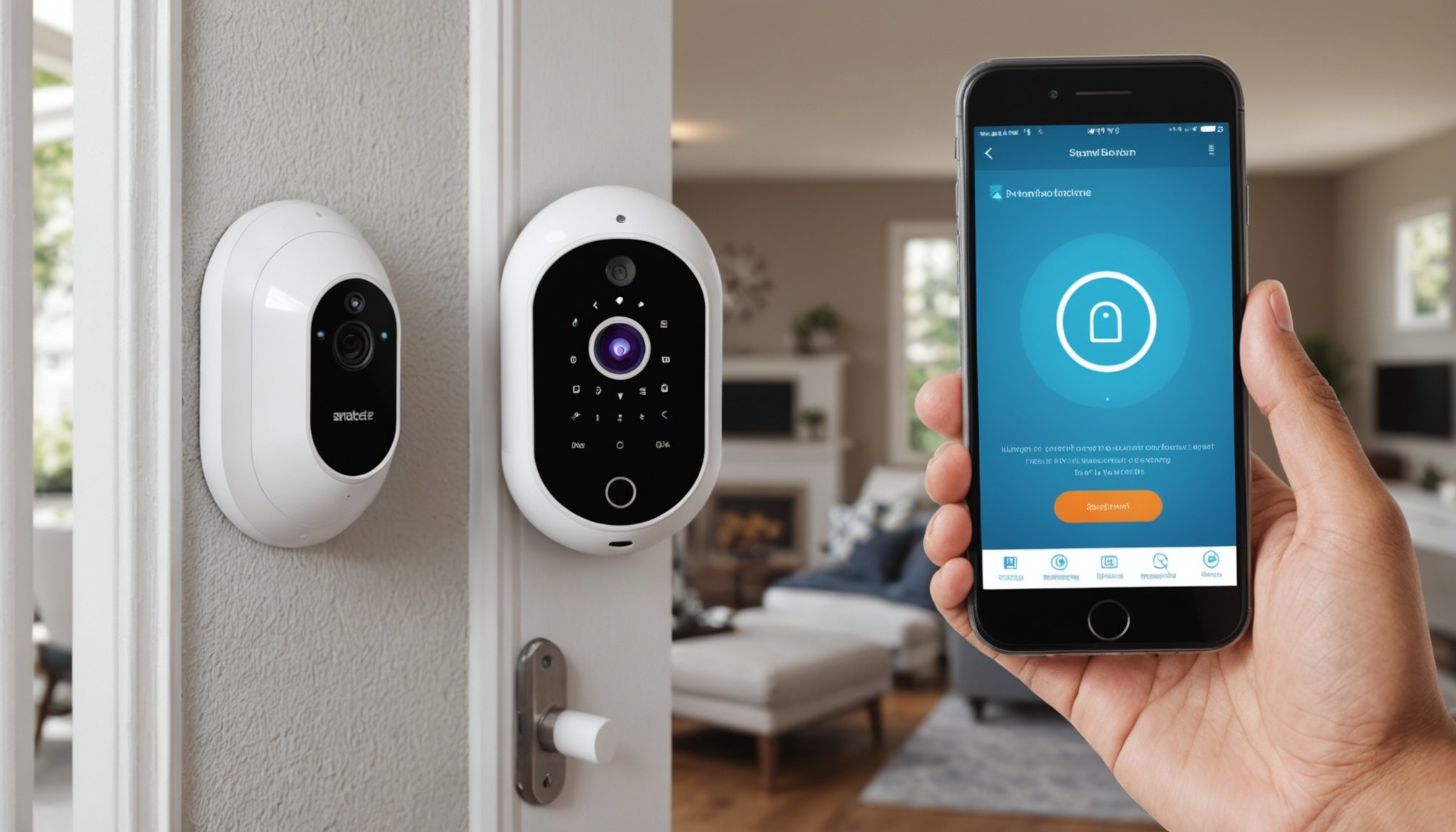Overview of Smart Home Security Systems
Smart home security systems are designed to protect your home by integrating various technological components that work together to increase security and convenience. They typically include devices like cameras, motion sensors, and alarms that connect to a central hub or are controlled via a smartphone app. This connectivity allows for real-time monitoring and notifications, which can be managed from anywhere.
One of the significant benefits of smart home security systems is their ability to leverage smartphone technology, providing a user-friendly interface for security management. This allows homeowners to receive immediate alerts about security breaches, remotely control devices, and even interact with visitors through smart doorbells equipped with video cameras.
When selecting a smart home security system, it is essential to consider key features such as energy efficiency, integration with other smart home devices, and the ability to customise alerts. Look for systems that offer biometric access, AI-driven threat detection, and seamless integration with voice assistants for added convenience.
Overall, these systems not only enhance the safety of your home but also contribute to an efficient and connected living environment. They represent the forefront of home security innovation, making them a worthwhile investment for tech-savvy homeowners.
Preparation for Installation
Preparing for the installation of your smart home security system is a crucial step to ensure its effectiveness. Start by conducting a site assessment to evaluate your home’s layout and identify vulnerable entry points that need monitoring. Consider factors such as the number of floors, windows, and doors. This will help determine the types and number of devices required, such as cameras and motion sensors.
Compatibility with existing smart home technology is essential. Make sure your chosen security components are compatible with current devices and systems already in place. Check for interoperability with smart hubs or assistants like Amazon Alexa or Google Assistant.
Before starting the installation, gather necessary tools and materials. These may include drills for mounting cameras, screwdriver sets for sensor placement, and adhesive strips for easy attachment of devices. It’s also wise to ensure your internet connection is strong in all areas where devices will be installed to support seamless integration and communication.
Proper preparation and planning are the keys to a successful smart home security system installation, ensuring your home is protected with minimal disruptions. Remember, taking the time to plan effectively will save hassle in the long run.
Step-by-Step Installation Guide
Embarking on your smart home security system journey? Fear not! We’ll guide you through the installation instructions, ensuring each step is crystal clear.
Mounting Security Cameras
Ensuring optimal surveillance begins with the correct placement. Mount your cameras at strategic angles to cover entrances and key areas of interest. Position them high enough to deter tampering but low enough for a clear view. Most cameras require a stable surface and a robust bracket for longevity. Attach the mounting bracket to the surface, secure it tightly, and adjust the camera to the desired angle.
Installing Motion Sensors
For effective motion detection, follow these foolproof steps: Identify locations with high foot traffic, ensuring unobstructed areas. Install sensors approximately 6-12 feet above the ground. Secure them with screws or adhesive strips. Connect to the power supply as outlined in the step-by-step guide, allowing the sensors to calibrate and be ready for action.
Setting Up Door and Window Sensors
Ensure security by placing sensors on all entry points. Begin by aligning the sensor pieces so they can detect when the door or window opens. Use screws or adhesive to secure, testing each sensor for connectivity. Similarly, ensure the sensors are linked correctly per the manufacturer’s directions to avoid any security lapses. With these steps, your security system will be up and running effectively.
App Setup and Configuration
Seamless app installation is central to any smart home security system. Begin by downloading the smartphone app recommended by your system provider from either the App Store for iOS devices or Google Play for Android. Installation is typically straightforward, requiring only standard app permissions.
Once installed, the device pairing process can commence. Usually initiated by selecting ‘Add Device’ within the app, follow the step-by-step guide provided. This process may involve powering up each security component and synchronizing it with your home Wi-Fi network. Ensure that all devices are within the router’s range to avoid connectivity issues.
Establishing user accounts within the app is crucial. This feature facilitates security management by enabling individual family members to access the system. It also allows the setup of permissions, so you can decide who can perform actions such as adjusting settings or viewing camera footage.
To boost security, the app may request the setup of authentication methods like biometrics or passcodes. These add an extra layer of protection, ensuring only authorized users can make changes to your security system settings. Prioritize configuration for enhanced control and personalized alerts.
Device Integration and Automation
Integrating your devices with existing smart home systems enhances security and convenience. Start by linking your smart home security system with other devices like smart lights and alarms. This integration allows for comprehensive control through a single platform, reducing complexity in managing multiple systems.
Explore automation options to streamline your security measures. For example, set the smart lights to switch on automatically when motion is detected by sensors. This kind of automation not only deters potential intruders but also enhances energy efficiency by ensuring lights are used only when necessary.
Within the app, focus on customising alerts and notifications. Tailor these settings to suit your lifestyle, ensuring you receive timely updates on security breaches or system status. This might involve setting different alert tones for various events or specifying which devices send notifications at particular times.
Moreover, consider integrating voice assistants like Amazon Alexa or Google Assistant. This feature allows you to control your security system using voice commands, offering hands-free convenience in managing alerts, arming and disarming systems, and even checking the status of window and door sensors. Voice integration can be particularly useful for those with mobility issues or for quick access in emergency situations.
Troubleshooting Common Issues
Even the most advanced smart home security systems can face challenges. Identifying and resolving these common issues ensures efficient operation. Troubleshooting typically begins by checking connections. If the system doesn’t seem to connect, first, verify that the devices are within the router’s Wi-Fi range. Ensure they’re connected to the correct network and that your Wi-Fi signal strength is adequate throughout your home.
If the smartphone app is not syncing with devices, try restarting both the device and the app. Sometimes, a simple restart can solve connectivity issues. Check for any available updates for the app or device firmware as they often contain bug fixes and improvements.
Should motion sensors or cameras fail to activate, ensure that they’re correctly powered and that their settings are appropriately configured within the app. Occasionally, recalibration or resetting the device to factory settings may be required.
When these steps don’t resolve the problem, don’t hesitate to utilise vendor support options. Many manufacturers offer comprehensive online guides, help desks, or dedicated customer support teams to assist with more complex issues, ensuring your home security remains uncompromised.
User Reviews and Recommendations
Understanding how user reviews and performance feedback can impact your decision when choosing a smart home security system is crucial. They provide real-world insights into system reliability and user satisfaction.
Top-rated Smart Home Security Systems
When selecting a security system, consider top-rated options like the Arlo Pro 4, Ring Alarm, or SimpliSafe. Users often praise these for their reliability, ease of use, and excellent customer support. These systems commonly feature comprehensive coverage and innovative technology, ensuring robust protection for your home.
User Experiences and Ratings
Users frequently highlight features such as seamless integration, intuitive apps, and responsive support as key advantages. Ratings often underscore the importance of robust connectivity and feature-rich smart home automation. It’s essential to research user experiences to find systems that align with your specific needs and expectations.
Recommended Installation Services
For those less confident in DIY, professional installation services can ensure optimal setup and performance. Companies often provide tailored support, making sure compatibility with existing devices and systems is maximized. When investing in professional help, check reviews for the most reliable services, ensuring peace of mind and an efficient installation process.
Visual Aids and Resources
Understanding how to effectively install and manage your smart home security system can be greatly enhanced through the use of visual aids. Instructional videos offer step-by-step demonstrations, bringing clarity and confidence to even the most technophobic users. Websites like YouTube and security brand sites often provide comprehensive tutorials, showing exactly how to mount cameras or sync devices.
Additional resources such as user manuals, software guides, and forums can offer insights that videos might gloss over. These materials are generally updated with the latest features and troubleshooting techniques, offering robust support for homeowners keen on DIY installation.
Visual aids not only simplify complex instructions but serve as a handy reference point during various stages of setting up and configuring your system. The precision they provide ensures tasks like device integration and automation are done without hiccups. For those seeking an interactive experience, augmented reality apps are emerging as innovative tools, offering a virtual walkthrough of system setup.
For further learning and detailed installation preparation, some brands include QR codes on product packaging that link directly to instructional content tailored to the specific device model. Such resources are invaluable for a seamless and efficient setup experience.


